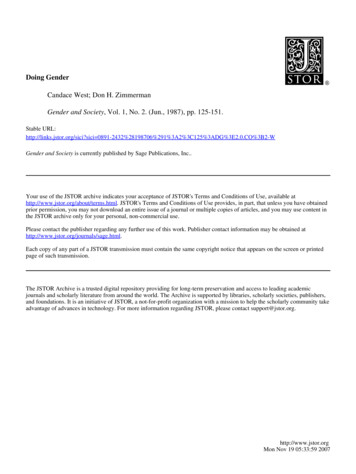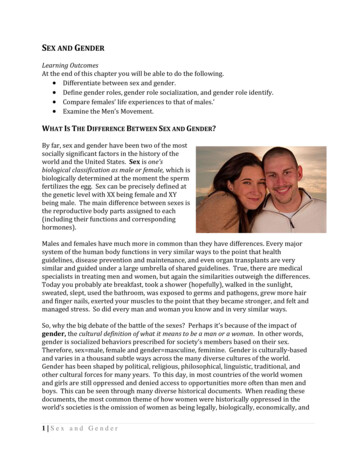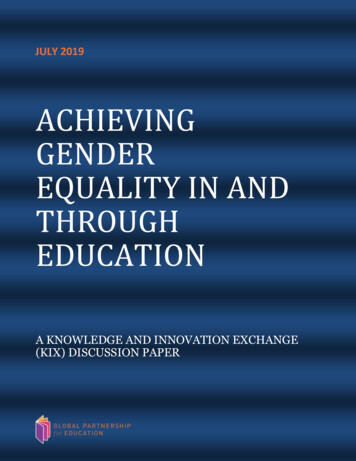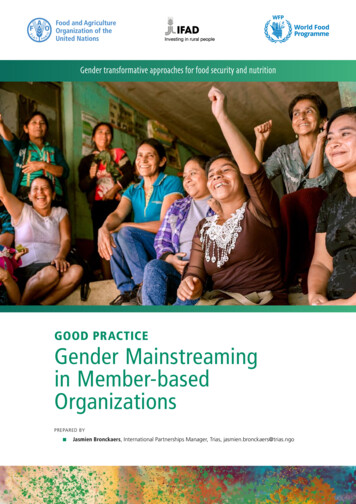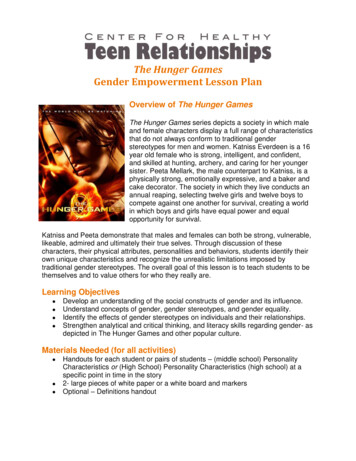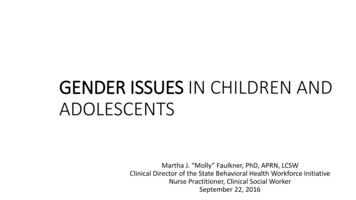
Transcription
GENDER ISSUES IN CHILDREN ANDADOLESCENTSMartha J. “Molly” Faulkner, PhD, APRN, LCSWClinical Director of the State Behavioral Health Workforce InitiativeNurse Practitioner, Clinical Social WorkerSeptember 22, 2016
OBJECTIVES1. List 3 critical issues related to gender and non-conforming genderchildren and adolescents face.2. List definitions of sex, gender, non-conforming gender, gender identity,gender roles, and gender fluidity.3. Specify 3 strategies how to best support gender nonconforming youth toprevent negative health and behavioral health outcomes.
Question 1One of the most critical issues regarding gender thatchildren and adolescents of nonconforming genderface:a) suicidalityb) nonsuicidal self injuryc) lower school performanced) all of the abovee) a and b
Question 22. The definition of gender fluidity is:a) flexible range of gender expressionb) interests and behaviors shift over timec) a & bd) None of the above
Question 33. Strategies to help support gender nonconforming youthare:a) be alert for gender nonconforming students and bullyingb) listen and learn what youth feels about genderc) encourage school district policy addressing protection of gendernonconforming studentsd) All of the above
EPIDEMIOLOGY OF GENDER NON-CONFORMINGYOUTH No formal epidemiologic studies exploring the prevalence andincidence of gender nonconformity in youth Estimates exist in GN adults, about 1%Vance et al, 2014
GENDER AND GENDER NONCONFORMITY“The “why” of gender and gender nonconformity continues to be amystery, but all evidence points to gender development being anintricate interweaving of nature, nurture, and culture.” Diamond, 2002
GENDER DEVELOPMENT Endocrine, genetic, and neurological data support biological component. Past psychosocial paradigm parents have the greatest influence on achild’s deviation from acceptable social gender norms or a child’s refusal toaccept the implied gender based on the natally assigned sex Currently understood to be a “feedback loop” with the child shaping theparents as much, if not more, than the parents shaping the child. Within this interaction, the child’s gender is perceived as generated fromwithin while also being influenced by the social environmentDessens et al., 2005; Coolidge et al., 2002; Berglund et al., 2008; Heylens et al., 2007.
DEFINITIONS Sex Gender Non-conforming gender Gender Identity Gender Roles Sexual Orientation Coming Out Gender Fluidity Pan Sexual
SEX- a person’s biological status Typically categorized as: male female intersex (1.7%) Sex chromosomes Gonads (ovaries, testes) Internal reproductive organs External genitalia (labia, scrotum, penis, clitoris)
GENDER Taught “blue for boys” “pink forgirls” Culture determines gendercompatible with culturalexpectations Gender non-conformity Attitudes, feelings, and behaviors behaviors that are viewed asincompatible with thesethat a culture associates with aexpectationsperson’s biological sex. Gender normative-behavior
NON-CONFORMING GENDER A person who doesn’t adhere to societal pressures toconform to gender norms and roles.
GENDER IDENTITY How an individual identifies in terms of their gender.Since gender identity is internal, one’s genderidentity is not necessarily visible to others.
GENDER ROLES Set of societal norms dictating the types of behaviors whichare generally considered acceptable, appropriate, or desirablefor people based on their actual or perceived sex or sexuality.
SEXUAL ORIENTATION Determined by one’s emotional, physical and/or romanticattractions. Categories of sexual orientation include, but are not limited to:GayLesbianAttracted to somemembers of the samegenderBisexualAttracted to somemembers of more thanone genderAttracted to somemembers of anothergender.HeterosexualPansexualGender Fluid
SEXUAL ORIENTATION AS A CONTINUUM Sexual orientation does not always appear in such definablecategories and instead occurs on a continuum (e.g., Kinsey, Pomeroy, Martin,& Gebhard, 1953; Klein, 1993; Klein, Sepekoff, & Wolff, 1985; Shiveley & DeCecco, 1977) In addition, some research indicates that sexual orientation isfluid for some people; this may be especially true for women(e.g., Diamond, 2007; Golden, 1987; Peplau & Garnets, 2000).
COMING OUT Process in which one acknowledges and accepts one’s ownsexual orientation. Figure of speech for lesbian, gay, bisexual and transgender(LGBT) people's self-disclosure of their sexual orientationand/or gender identity
GENDER FLUIDITY Conveys a wider, more flexible range of gender expression,with interests and behaviors that may even shift from day today, over time or depending on the situation
GENDERFLUIDITY
PANSEXUALITY A person who is emotionally, physically and/or romanticallyattracted to some people, regardless of that person’s genderidentity or biological sex. Describes people who are capable of being attracted to multiplesexes or gender identities.
GN HOW IDENTIFIED IN CLASSROOM/SCHOOL? Child of one biological gender wears clothing or plays exclusivelywith toys of the opposite gender or states they prefer to becalled a name of the opposite gender. Child may wear clothing typical of one gender and then the nextday wear clothing typical of another.
GN HOW IDENTIFIED IN MEDICAL CLINIC? Younger children: Parents bring in to clinic as concerned their son prefers to playwith dolls or wear dresses or bring their daughter because sheprefers to be called a traditionally male name or even explicitlywishes she were a boy. Is this a phase? Is this early indicator of being transgender? Homosexuality?
HOW IDENTIFIED IN MEDICAL CLINIC? Adolescent: GN youth may present after progression of puberty triggers increasedgender dysphoria (prior to DSM 5 known as gender identity disorder) orpresence of clinically significant distress associated with one’s biologicalgender being different than their gender identity
DSM5 GENDER DYSPHORIA – HAS OWN CHAPTER Marked difference between the individual’s expressed/experienced genderand the gender others would assign him or her Must continue for at least six months In children, the desire to be of the other gender must be present andverbalized Causes clinically significant distress or impairment in social, occupational, orother important areas of functioning.
GENDER DYSPHORIA No validated measurement scales Prevalence data unknown 1.3% of San Francisco middle school studentsidentify as transgender 1 New Mexico data unknown Sex ratios2 Initially data suggested 2:1 ratio of natal males to females,now 1:1 (since roughly 2005) Not all gender TGNC youth have gender dysphoria Not all youth with gender dysphoria want medical or surgicalinterventions Shields, 2013; Aitken, 2015slide ofAdapted from Nate Sharon, MD
GENDER DYSPHOIA MANIFESTATIONS Strong desires to be treated as the other gender or to be rid of one’s sexcharacteristics A strong conviction that one has feelings and reactions typical of the othergender. The DSM-5 diagnosis adds a post-transition specifier for people who areliving full-time as the desired gender (with or without legal sanction of thegender change). Ensures treatment access for individuals who continue to undergohormone therapy, related surgery, or psychotherapy or counseling tosupport their gender transition.
CRITICAL ISSUES FACED BY GN YOUTHStigmatization, social rejection lack of family support leads toadverse mental health and medical outcomes Risk of victimization by theirpeers Suicidality Depression Anxiety Oppositional Defiance Lower school performance Nonsuicidal self-injury Drug abuse Alcohol abusePhysical assaultSexual violence40% of homeless youth areLGBTQ More likely to have lower GPAS,miss school or drop out of schoolearly because of harassment.Greytak, 2009; Haas, 2011
CO-OCCURING MENTAL HEALTH PROBLEMS Higher rates of PTSD, depression, anxiety, self-harm behaviors, suicideattempts compared to cis-gender and LGB peers 1, 2 Observed 7% co-occurrence of Autistic Spectrum Disorders in TGNC youthRecent study showed 23% of youth 8-20 presenting for gender services had “possible, likely or verylikely” Aspergers Higher rates of At risk sex behaviorsSubstance useHIVTrauma Protective Factors4 Caregiver acceptance Positive school environment1. Olson, 2015, 2. Reisner, 2015, 3. DeVries, 2010, 4. Moody, 2013Slide of Nate Sharon, MD.
CLASSROOM/SCHOOL INTERVENTIONS Learn about gender issues Be alert for children and adolescents who are GN and whether or not theyare being bullied Encourage the implementation of best practices- get district policy ontransgender and GN students Make curriculum inclusive- Insert into your curriculum topics around GNstudents where able Insert in curriculum general skills regarding how you like to be treated andhow to treat others Share GN material with your students Make referral to counselor when needed
CLASSROOM/SCHOOL INTERVENTIONS http://www.glsen.org/webinars School Push out of LGBTQ Youth US Anti-Bullying Efforts LGBT Youth in Rural schools and MORE
MULTIDISCIPLINARY APPROACH BESTMEDICAL/PSYCHOSOCIAL INTERVENTIONS Professional should get TRAINING as in gender issues or becomegender specialist Clinical assessment Psychotherapy Family Support Evaluation for social transitions to affirmed gender Later for psychological readiness for medical intervention Especially puberty blockers and cross –sex hormones.
MENTAL HEALTH PROFESSIONAL Listen and learn what youth is experiencing and feeling about gender Comprehensive gender history from birth to the present from youth and from parents Can begin with delineating their name, gender identity and preferred gender pronoun Challenging tasks Asses if youth’s GN signal of or solution to independent underlying emotional or psychiatric issues Determining authenticity of affirmed gender identity. Young children who: Early on wish they are different gender than biological gender assignmentTenacious in both their gender-fluid or gender-crossing expressions and identity affirmationsDemonstrate distress about the incongruence between their physicality and affirmed genderWill more likely evolve into transgender teens or adultVance et al., 2014
POSSIBLE GOALS OF GENDER NONCONFORMING YOUTH May seek care to understand their internal gender identities, Socially transition to their affirmed genders, and/or physically Transition to their affirmed genders(Vance, Ehrensaft, Rosenthal, 2014)
Question 1One of the most critical issues regarding gender that childrenand adolescents of nonconforming gender face:a) suicidalityb) nonsuicidal self injuryc) lower school performanced) all of the abovee) a and b
Question 1One of the most critical issues regarding gender that childrenand adolescents of nonconforming gender face:a) suicidalityb) nonsuicidal self injuryc) lower school performanced) all of the abovee) a and b
Question 22. The definition of gender fluidity is:a) flexible range of gender expressionb) interests and behaviors shift over timec) a & bd) None of the above
Question 22. The definition of gender fluidity is:a) flexible range of gender expressionb) interests and behaviors shift over timec) a & bd) None of the above
Question 33. Strategies to help support gender nonconforming youth are:a) be alert for gender nonconforming students and bullyingb) listen and learn what youth feels about genderc) encourage school district policy addressing protection of gendernonconforming studentsd) All of the above
Question 33. Strategies to help support gender nonconforming youth are:a) be alert for gender nonconforming students and bullyingb) listen and learn what youth feels about genderc) encourage school district policy addressing protection of gendernonconforming studentsd) All of the above
References Aitken M, Steensma T, Zucker K, et al (2015). Evidence for an altered sex ratio in clinic-referredadolescents with gender dysphoria. Journal Of Sexual Medicine. 12(3):756-763. Berglund H, Lindström P, Dhejne-Helmy C, & Savic I. (2008). Male-to-female transsexuals showsex-atypical hypothalamus activation when smelling odorous steroids. Cerebral Cortex,18(8):1900–1908. Coolidge, F., Thede, L., & Young, S. (2002). The heritability of gender identity disorder in a childand adolescent twin sample. Behavioral Genetics, 32(4):251–257. Dessens, A., Slijper, F., & Drop S. (2005). Gender dysphoria and gender change in chromosomalfemales with congenital adrenal hyperplasia. Archives of Sexual Behavior, 34(4):389–397. de Vries A, McGuire JK, Steensma TD, Wagenaar E, Doreleijers T, & Cohen-Kettenis P. (2014).Young adult psychological outcome after puberty suppression and gender reassignment.Pediatrics, 134: 696-704. Diamond, M. (2002). Sex and gender are different: sexual identity and gender identity aredifferent. Clinical Child Psychology and Psychiatry, 7(3):320–334
References Greytak, e., Koscis, J. & Diaz, E., (2009). Harsh Realities: The Experiences of Transgender Youth in Our Nation’sSchools. New York: GLSEN. Haas, A. (2011). Suicide and suicide risk in lesbian, gay, bisexual, and transgender populations: review andrecommendations. Journal of Homosexuality, 58(1):10-51. Heylens, G., De Cuypere, G., Zucker, K., et al. (2012) Gender identity disorder in twins: a review of the case reportliterature. Journal of Sexual Medicine, 9(3):751–757. Newman L. (2012).Children with atypical gender development. In Rey JM (ed), IACAPAP e-Textbook of Child andAdolescent Mental Health. Geneva: International Association for Child and Adolescent Psychiatry and AlliedProfessions. Olson, K., Durwood, L., DeMeules, M., & McLaughlin, K. (2016). Mental health of transgender children who aresupported in their identities. Pediatrics, 137(3):1-8. Reisner SL, Vetters R, Leclerc M, Zaslow S, Wolfrum S, Shumer D, & Mimiaga MJ. (2015). Mental health oftransgender youth in care at an adolescent urban community health center: a matched retrospective cohortstudy. Journal of Adolescent Health, 56(3):274-9. Shields, J., Cohen, R., Glassman, J., Whitaker, K., Franks, H., & Bertolini, I. (2013). Estimating population size anddemographic characteristics of lesbian, gay, bisexual, and transgender youth in middle school. Journal ofAdolescent Health, 52(2): 248-250. Vance, S. R., Ehrensaft, D. & Rosenthal, S. M. (2014). Psychological and medical care of gender nonconformingyouth. Pediatrics 2014;134:1184–1192. oi:10.1542/peds.2014-0772
RESOURCES, SUPPORTSInternational/national World Professional Association for Transgender Health(wpath.org) Endocrine Society upport-trans-and-gnc-studentsTrans Youth Equality (transyouthequality.org)GenderSpectrum (genderspectrum.org)Trans Youth Family Allies (imatyfa.org)Transparenthood (transparenthood.net)Gay, lesbian, straight education network (www.glsen.org) –Schools in Transition: A Guide forSupporting Transgender Students in K-12 Schools (genderspectrum.org)Camp ARANU'TIQTrans Active Gender Center (transactiveonline.org)The Trevor Project (thetrevorproject.org)Trans Lifeline, 1-877-565-8860Slide of Nate Sharon, MD.
OBJECTIVES 1. List 3 critical issues related to gender and non-conforming gender children and adolescents face. 2. List definition



